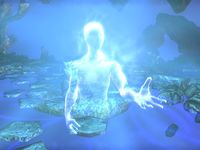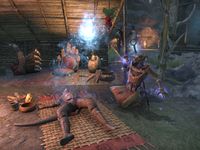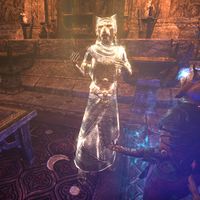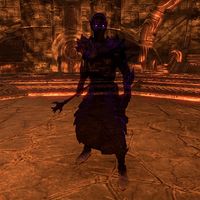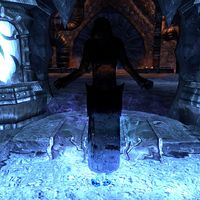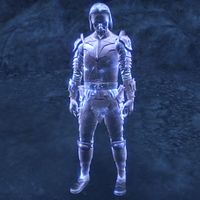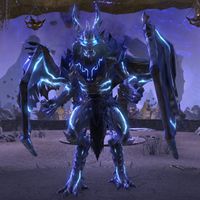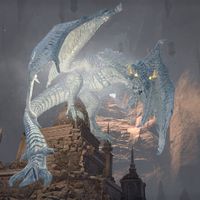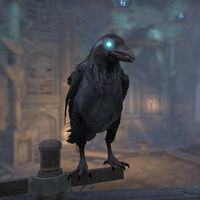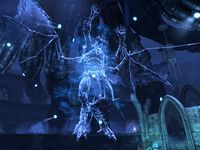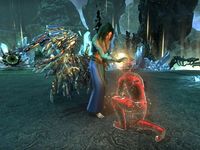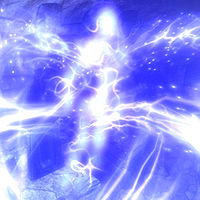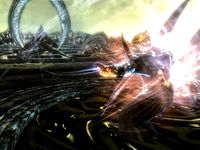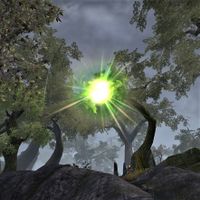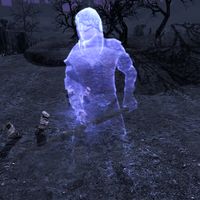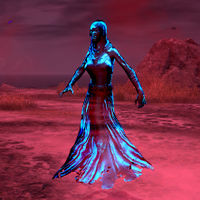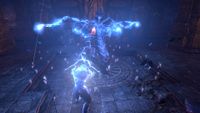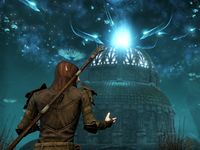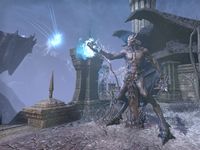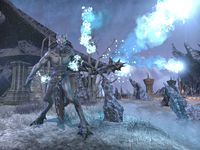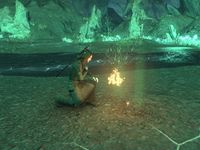Lore:Souls
The Soul, also known as the Animus, is a feature of an entity which seems to be closely connected to its animating consciousness and the body it has, both spiritual and physical. All living things on Nirn seem to have a soul, though the souls of more intelligent and stronger creatures tend to be "larger" (more powerful). Under ordinary circumstances, the mind and soul of a mortal are intertwined. The word, "soul", is almost exclusively used to describe Anuic animus that mortals possess,[1] though other entities like Dragons and Daedra also have an animus that serves a similar function.
Souls are generally immortal though there have been a few cases of spirits that got erased from existence, like Umaril the Unfeathered. In death, a mortal's soul usually journeys to Aetherius, where it remains forever. Mortals who made a binding pact with a Daedric Prince, who retain strong emotional ties to the mortal realm, or who are affected by certain spells, may instead find their souls on Mundus or one of the planes of Oblivion. It is possible to trap and manipulate souls through necromantic arts and spells like Soul Trap.
It is possible that souls are composed of various parts and influenced by variables that are yet to be understood, for example a Shadow of the soul can be separated from it and transformed into an independent entity, leaving the original soul in a weakened state.[2][3] Other anomalies of soul mechanics include the odd nature of Cadwell, who shared his consciousness between his old body and the one formed by his Vestige, resulting in two distinct versions of the same person. While the precise nature of the souls is uncertain, what can be known is that souls are a source of mystic energy.[4] Soul Magic, Enchanting, Necromancy, Mysticism, and Conjuration all make use of this energy. Soul gems are the most common method of trapping souls, especially for enchanting, although items such as animus geodes and auricular geodes[5] can be used in some cases.
Mortal Souls[edit]
Characteristics[edit]
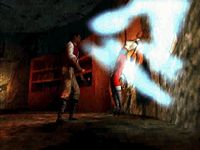
The Anuic animus of mortals, commonly referred to as a "soul",[1] is described as having certain characteristics. It has been described as the piece of every mortal which comes from Aetherius, the realm of pure light and magic, and a "tiny star" which flares into a "sun" when magic is invoked.[6] Souls can accumulate magicka over time.[7]
The spirits of mortals are noted for their mutability, in contrast to the Daedra who are described as largely immutable and static, incapable of experiencing change in spiritual nature or certain aspects of character,[8][9][10][11][12] or to Nature Spirits who are said to always return to a core nature,[13] mortals can change, in their nature, their ways, their names,[14] which makes them stand out. Because of this difference in mutability, even a mortal who's received power from a Daedric Prince to achieve transformation into a "mock-Daedra" remains mortal in terms of nature.[8] This mutability is said to extend to a soul's vessel, where a mortal might change their spirit's vessel through some basic magic, a change a number of mages have undergone, taking on forms such as that of a Voriplasm , a tree, a Tomeshell, a Giant, a Golem or Flesh Atronach, or even a Dragon skeleton,[15][16][17][18][19][20][21] a Daedra's form is defined by their Nymic or "incantatory true name" in it's one changeless form.[14]
According to Hermaeus Mora, it is the nature of mortals to always have a chance to succeed and reach a desired outcome even when it would otherwise be impossible, a quality not possessed by immortal beings like himself who would inevitably fail in the same circumstances.[11]The unique ability of mortals to choose their own fate is also affirmed by the Daedric Prince Ithelia, according to whom mortals, unlike immortals such as the Daedra, possess the ability to change who they are and alter their own fates naturally, without the need of magic or divine power, something which beings such as herself or her servants are incapable of.[9]
Unlike the Vestiges of Daedra, the souls of mortals are described as not fettered to existence, with the proper rites they can be "decoupled" from the body entirely and persist as immortal spirits that sustain themselves by consuming other souls. This unmooring process is not the same as the soul being separated from the body at death because then the resulting spirit is dead, a Ghost, whereas if separated prior to death the mortal becomes a living spirit.[22]
Recuperation and Reincarnation[edit]
Even when a soul has been sundered by powerful magic, it is said it can eventually recoalesce in the same location, given enough time.[23] Indeed, the fragments of a spirit shattered by magic need to be bound by spells to prevent them from seeking each other out and reforming into the whole, and will proceed to recoalesce once the spell keeping them apart is lifted.[24]. Magic can be used to bind a spirit from moving on to the afterlife, but it is said even such souls can find a way to move on eventually.[25] There have been cases where the spirit of a dead mortal has entered the body of a living being and integrated itself with the living soul residing there. Though ghosts have the ability to possess and animate both living and dead bodies as well as inanimate objects by entering them[26][27][28][29][30], such phenomena are said to not be the same thing as this spiritual integration. Whereas in a possession the soul of the spirit remains distinct and either exerts direct control over the host body or influences the host's thoughts and emotions, with the host soul sometimes being expelled or having its identity erased outright,[31][32][33] the integration phenomenon results instead in the soul of the spirit merging with the soul of the living host without exerting control, thus the spirit is effectively reborn or reincarnated into the living host, who will than start to experience the memories of that spirit as if they'd lived through them, manifesting the knowledge and abilities the soul reincarnated within them possessed and feeling its emotions as their own. The phenomenon has also been described as a spirit being resurrected as the "twin soul" of its host. The initial entry of the soul into the living body is accompanied by a brief bout of intense pain, after the rebirth, other spirits who knew the reincarnated soul in life can sense its presence within its reincarnated form and realize the host soul and the reincarnated soul as now being the same. Though such spiritual rebirth is possible, it is said that it is relatively rare for spirits to behave in that manner.[34][35][36][37]
Composition[edit]
According to the Order of the Ancestor Moth, mortal souls are the Aedric essence at the core of every mortal's existence. They can be likened to the wings of a butterfly, scaled and full of vessels which become filled with the experiences of mortal existence. It is said that upon death a process of dissipation whereby some of these accumulated contents disperse. These essences, the Fjyrons or "will to peace", are believed to retain a connection to both the grand fabric of creation and to all aspects of the soul in all their destinations. Thus because, all aspects of a soul remain connected, tapping into the Fjyrons allows one who knows how to receive the erudition of the ancestors. Knowledge and guidance from beyond mortality, from the existence beyond the present and the past and the known world, where time is irrelevant, thus allowing one to glimpse the cosmic tapestry and its threads. The Ancestor Moths of the Order are said to imbibe the Fjyrons, described by some as the memories of the dead,[38] becoming animated by the Fjyrons of the ancestor spirits, shepherding that wisdom and passing it through the generations. Thus their trilling forms a sort of primal augur which allows the Order to read and interpret the contents of the Elder Scrolls which contain knowledge said to exceed even the gods.[39][40][41][42] The mortal soul contains certain facets, the Shadow is said to be the darkness which innately belongs to mortal souls, an integral part of a creature's animus, it being damaged while attached to the rest of the soul is equivalent to the soul being damaged and can lead to death.[43][2][3] In at least one case, a mortal's essence was separated into their aspects of Magicka, Health and Stamina through magic.[44] A mortal's emotions such as fear, anger, happiness, and sadness make up different aspects of their animus and can express their own will when allowed to by magic. Certain types of magic such as the Silaseli Dream State of the Ayleids can allow these emotion-aspects to separate themselves from their soul of origin and manifest in spectral forms, rendering the mortal incapable of feeling those emotions until they are returned. Emotion aspects separated in this manner retain the ability to use magic.[45][46][47][48] Though souls can be sundered through the use of powerful magic, it is said the spirit can eventually recoalesce, given enough time,[23]in addition to their fragments eventually reconstituting on their own, shattered spirits can also be restored through the use of Soul Magic, a process which can also allow for souls that have been altered as in the case of the Dro-m'Athra to be restored to their original state.[49] The mortal soul is said to contain tremendous power, but it also places certain checks on mortal will which obstruct the mortal from accessing it, separating the soul from the body, as is done through the process of transformation into Lichdom, is said to remove such boundaries, opening the door to a virtually limitless magical horizon.[49] According to the necromancer N'gasta the mortal soul holds immense power which mortals themselves remain generally unaware of, an "unearned grace" granted by the Outer Gods who "give too plenty and without good guidance" which, if it was understood, would make them place more importance in safeguarding their souls over their bodies. Thus N'Gasta likens the soul itself to a flame and the body to an easily slipped skin akin to paper, which gradually withers not able to long withstand the fire within it.[50] Some sources claim that spiritual corruption manifests within the soul as a tangible thing, something which those with the required knowledge and skill can isolate and remove, leaving the soul itself alive and healthy. Such an ability is said to have been possessed by Saint Veloth, whose ability to distinguish good from bad and skill as a healer were combined in his symbol of power, the artifact Veloth's Judgment, which could cleanse souls of corruption by siphoning it from the spirit in a precise manner. Whatever the case, using the same process to siphon a living creature's entire soul instead, can grant the one using it immense power.[51][52][53][54] It is said that even a magically fractured mind retains subconscious memories of past experiences such as echoes of past trauma, which are written in the fault lines of the soul itself, and can be read to reveal the truth by those who know how.[55] According to some accounts, the Hunger of Sep exists deep within the core of every mortal, it is a thing that can never be sated and is related to mortals being overtaken by greed. It is said that those who pursue avaricious desires can be taken body and soul by the Hunger of Sep, leading to calamity. Being taken by this "hunger" is said to be what caused the Samara Scarabs to transform into the Assassin Beetles of today, growing larger and sprouting rending claws and mandibles due to its influence.[56]
Transition to the Afterlife[edit]
The soul of an individual on the precipice of death can manifest in a spectral form, similar to a ghost. A soul burdened by strong emotions such as regret can splinter, its parts manifesting simultaneously in multiple locations tied to those emotions.[57] Such souls, caught between life and death, can be prevented from moving on to the afterlife through the use of powerful magic. However, even the power of a Luminary can't prevent a soul from passing on to Aetherius indefinitely, and powerful wraiths might eventually arrive to force the transition into Aetherius.[58][59] It is said that after death a soul can wander for a time, its path forward darkened by its transgressions in life. A soul can sense the afterlife calling to them when its time for them to move on. Such spirits, held back by guilt and unresolved affairs, might refuse entry into the afterlife even if they have been accepted into it, holding themselves back as long as their unresolved affairs remain. Being summoned to provide aid to the living, through lending their strength or inhabiting and animating bodies willingly, is said to be one of the ways through which spirits can resolve the issues that keep them from the afterlife, once employed by certain branches of necromancy such as that used by the Order of the Hidden Moon. In some cases these powerful unresolved emotions might cause the soul itself to crack and be wounded, allowing for a Void to be created within it. Forgiving one's self can heal the Void-wound, allowing that spirit to proceed to the afterlife beyond.[36][60] [35][34][61]
Related Arcane Phenomena[edit]
Souls are described as being linked to the origin of certain phenomena. When a mortal dies their memories become Water,[62] with rivers of memory even connecting Nirn to realms beyond,[63] and the oceans being described as extending beyond the three dimensions mortal senses perceive, and as having a true nature that can be fatal to witness.[64] Because of this, with the proper knowledge, the memories drawn from mortals can be coalesced to create a Water Stone, an artifact capable of creating an endless supply of water, said to be very close in nature to that of a nature spirit of water.[65][62][66] According to some sources all waterways connect the realms of the living and the dead, being the means by which spirits cross over into the living world.[67] The memories a mortal accumulates throughout life, much like their lifeforce, can be tapped into through magic, potentially serving as a source of power for spells and curses. Absorbing a spirit's memories is equated to absorbing its essence itself, thus lifeforce drawn from the body can manifest as memories, and memories either manifested through magic or tied to an object with emotional significance can provide the one they originate from with lifeforce. A spirit's memory is known to serve as a potent source of mortus energy, the magical energies of necromancy.[68][69]. Through the use of magic, a mortal's memories of another individual can even be extracted to create a version of that individual that can go on to substitute the original in the role they were meant to perform.[70][71] In addition, a mortal experiencing suffering or death is said to produce necromantic energies which can stain the area where such events occurred and trap the souls of those present to haunt it, or serve as a reserve of magic for necromancers.[72] It is said that those who died within a perilous area such as a swamp never really leave, thus their tormented ends can infuse the very land itself, haunting and transforming the living things that reside there, and causing them to take on spectral traits themselves.[73] A soul's essence can be given fully in order to cast especially powerful magic, sacrificing the spirit's independent spectral existence in the process. Such an event occurred when the spirit of the mage Alanwe sacrificed herself to banish the fully powered Ebony Blade from Tamriel for a long time and cursed it to never stay with any one wielder for long, despite the will of its creator Mephala and the Blade's magic attempting to resist.[24] A soul is said to develop arcane connections to people and objects interacted with, and indeed it is said that because of this all things are magically connected, practicioners of Soul Magic can perceive these connections and even influence them should they desire to, touching or strengthening them with focus, this is described as "deep magic" compared to something like weaponizing soul essence for use in combat.[74][75] As emotions of love are said to create a real arcane connection between two souls, one who has such a bond with another soul can draw upon the loved one's soul for power should they know how. In cases where a soul's strong unresolved emotions have caused a Void to form within it, this arcane link can allow for that Void to be tapped into, serving as a source of great power. A soul's Void can even be used to create a rift across the planes, a shortcut allowing one to bypass planar boundaries to the afterlife. [36][35][34]
Souls with Distinct Characteristics[edit]
Because of their connection to the Hist, the souls of Argonians are said to have unique qualities not shared by souls of other races of Tamriel.[76] Normally when they die they are able to return to the Hist tree which is bound to their tribe, but if that is prevented or the tree is suffering, the soul may remain as a ghost.[77]The souls of Khajiit are also described as having unique qualities, an innate duality or choice to be made not found in other souls, which is what allows for their transformation into Dro-m'Athra, dark spirits who have been described as "bizzare mutants" of a Daedric nature by the Daedra themselves. It is said by master necromancers that to view Dro-m'Athra as either just a form of Daedra or as just corrupted mortal souls is not quite accurate.[49][78] Khajiit Twilight Cantors have described the Dro-m'Athra as the "shadowed face" of the Khajiit which echoes the light and dark facets of the moons, a form the Khajiit takes after succumbing to the Dark Heart's call, which the Khajiit can naturally hear, due to rage and anguish.[79] A Dro-m'Athra's formation is described as the result of the Void seeping into cracks which are created in the soul when one hears the beat of the Dark Heart.[34], such cracks which can invite the Void are also said to form when one feels an emotion so strong it fills the spirit so completely as to make it crack.[80] The Bent Dance calls to the spirits of the Khajiit even in death, and spirits which have not yet reached Azurah's Crossing can still hear and be lured by it.[60] One Khajiit account describes how a Khajiit souls travels to Azurah's Crossing after death, and encounters Azurah herself. At that point the spirit remembers that it has lived and experienced the passage to the afterlife many times, and mentions it to Azurah. To this observation Azurah responds that the spirit has "walked many paths" to stand before her.[81] The Altmer view themselves as "true children of the Et'Ada", descendants of the Aldmer and of the Ehlnofey, which is to say of the Aedra or "Divines" that preceded the Aldmer, in an "unbroken line" dating back to Nirn's creation. Thus they believe that the "divine spark" is housed within each of them.[82][83][84]
Nature and Spiritual Transformation[edit]
Though certain aspects of souls, such as them being a source of magical energy, are understood, their true nature has been described as ultimately unknowable, with every mage who has attempted to discover it vanishing without a trace.[4] Indeed, the Numinous Grimoire, an arcane tome held in Apocrypha that is said to be a dissection of the mortal soul in both life and death, and contains rites that allow one to "decouple" their soul from the physical and become an immortal living spirit, is said to destroy the minds of any mortal who reads it, with the knowledge within only being transmittable through the aid of immortals who've read it first.[85][86][22]
Some sources claim that mortal spirits experience a change upon reaching Aetherius, with many souls of mortals becoming spirits of a different sort in that place.[87] Many reports from across Tamriel describe a phenomenon where the souls of the dead adopt a variety of forms to return and speak with the living. Animals, plants, or even fearsome visions, are all reported manifestations. It is theorized that the Luminaries, immortal beings of pure magic, might have originated as mortal souls, being the spirits of Ascended Ancestors that transformed into their current state after death due to this described phenomenon. As the Luminaries themselves can't recall their origins, this theory remains unproven.[88][89] Whatever the case, however, a Luminary can indeed be created out of the essence of a mortal soul, as was the case with the Crow Luminary, who was created through a ritual devised by Ulfsild the Evergreen out of a portion of her own essence. Though the process is straining and the restoration of the spirit takes time, a soul that was used in such a manner will eventually recover.[90][91][92] The Psijic Order maintains that souls that cross over into the afterlife can grow to gain great power and rule there, with a particularly malevolent tyrant for example, feeding into the power of Daedra like Boethiah and Vaermina through their acts in life, and going on to "rule in Oblivion" after death. The Psijics believe that the "Daedra and gods to whom the common people turn" are themselves "no more than the spirits of superior men and women whose power and passion granted them great influence in the afterworld", and that while living they too were "bewildered" by their own ancestors going back to the original progenitors, the Acharyai.[93] Dunmeri ancestor worship likewise maintains that the spirits of the dead continue to exist in the world, being able to "know and affect the future, speak with other spirits and work great magic". They believe that recently deceased spirits are weaker but close to the living in spirit, quick to guide and protect, whereas older spirits are stronger but stranger and more distant, the Daedra being the oldest and greatest but also strangest of these. Malevolent spirits are considered "daemons and "devils" from whom benevolent " Hero" spirits protect.[94] Similar beliefs are found among the Tsaesci who believe ancestor spirits grow more powerful the more they are revered, thus allowing a well-honored ancestral spirit to cross from the afterlife into the living world with greater ease, take on different forms such as becoming a black bladed "golden warrior" that's "swift as the wind", grant great fortune or misfortune, commune through and alter dreams, and drag the living to the afterlife if angered.[95][96][97]
Role[edit]
According to the Daedric Prince Ithelia mortals, by their very existence and lives, help preserve and maintain Aurbis, every child born, war fought, or field plowed by mortals, helps stabilize reality itself. It is said that mortals were designed as servants to perform tasks that maintain reality and so, the limitations that constrain them, such as the inability to comprehend and traverse the Many Paths, were placed upon them intentionally. This truth, Ithelia claims, is generally kept from mortals, to minimize the risk of them disrupting the plans of those who benefit from this secret. Despite this, there are certain individuals who have been shown to not be bound by at least some of the usual mortal limitations, being able to comprehend and traverse the Many Paths without issue.[9]
Some sources claim that the reason for the cycle of life and death is that there exist too many souls for the physical world to hold, thus necessitating the existence of a process through which souls can spend some time living, learning, and progressing, before being ushered away to the spiritual realms so other souls can take their place. Keeping this balance of life and death is said to be the role of Arkay as a god.[98]
The essence of a mortal soul is one of those influences that, when joined with purest creatia from the realm of a Daedric Prince or Daedra Lord, can give rise to a Demiprince.[99]
Vestiges[edit]
Daedra lack an Anuic Animus, also known as a mortal soul,[1] each one instead possessing a Daedric soul known as a Vestige (sometimes also called an Animus).[100] When a Daedra is destroyed, either in Mundus or in Oblivion, its Vestige is banished to the "Waters of Oblivion", and than attracted back to the plane of Oblivion where it originated.[101][100][102][103] A Daedra reforms according to the pattern within its Morphotype (a concept which seems to be interchangeable with the Vestige though it more closely relates to the form of a Daedra) using Chaotic Creatia (e.g. the Azure Plasm of Coldharbour).[1] The reconstitution process has been described by at least one type of Daedra as being both irritating and unpleasant, involves action on the part of the discorporate Daedra, and can result in minor variations in the final reconstituted form, such as a body part that seems "shorter than it used to be."[104] A Daedric Prince can create a new Daedra by replacing an entity's original Animus with a Vestige, a process which was used to give rise to the original Daedric Titans.[105]
Unlike mortals, Daedra and their Vestiges are described as largely immutable and static, incapable of experiencing change in spiritual nature or certain aspects of character. It is said that they never grow or change, as that is the nature of Daedra who are "immortal" and "forever". This unchanging nature is described as applying even more so to Daedric Princes, with even the Princes themselves expressing inability to truly destroy or permanently remove the power of another Prince, even if that Prince desires it to be so. A case of this phenomenon was seen with the Daedric Prince Ithelia, who was stripped of her power and rendered "as powerless as a mortal" when first imprisoned, but couldn't be destroyed and gradually regained her power upon being released. Later, when Ithelia willingly relinquished her power to rid herself of the destructive rage it caused to grip her, it was determined that her nature as a Prince would always restore her to power and freedom sooner or later, whether she desired it or not, also causing the rage to return. This, the true nature of a greater Daedra's "princely disposition" made it necessary for Ithelia to be exiled to a different reality due to the threat she posed to existence.[8][9][10][11][12]
This immutability is reflected in some aspects of a Daedra's nature. A Daedra's form and nature are said to be defined by their Nymic or "incantatory true name" in it's one changeless form, described as a "pattern or formula that defines the being created when it manifests itself from the eternal chaos of Oblivion".[14] According to Hermaeus Mora, immortals such as the Daedra do not share the mortal quality of always having a chance to succeed and reach a desired outcome even when it would otherwise be impossible, and would inevitably fail in the same circumstances.[11]This limitation of Daedra is also affirmed by the Daedric Prince Ithelia, according to whom the natural ability of mortals to choose who they are and alter their own fates naturally and without the need of magic or divine power, is something which beings such as herself or her servants are incapable of.[9] The Vestiges of Daedra are unlike the souls of mortals in that they are fettered to existence.[22]
According to the Mazken Madam Whim, a renowned information broker operating out of Fargrave, the original formation of the Vestiges of lesser Daedra is generally the work of a progenitor Daedric Prince, who forms them out of the Creatia of their realm and sets their nature and path at the time of their making.[99] There have been cases of lesser Daedra that were created by their progenitor Prince to accomplish a specific purpose or task, such as the scions of Ithelia, who were created by their Prince to help avert her foreseen imprisonment after a conflict with the other Daedric Princes.[9]"
Though normally unchanging, a Daedra's Vestige and therefore it's Morphotype can be altered and given new qualities through vestigial hybridization, a process through which a Vestige is given traits originating from a different Vestige thus allowing a new type of Daedra to be created. Examples of this process include the creation of the Xivkyn by Molag Bal through the combination of elements from both Dremora and Xivilai within the Vile Laboratory, and the transformation of Valkyn Skoria, who became a being of elemental fire through the addition of elements from Flame Atronachs to his Vestige by Mehrunes Dagon.[106]
It is possible to trap the animus of a Daedra by magically infusing it into an item.[107] It is not known what happens to a Daedra killed in Aetherius,[108] though it has been suggested that this may be one way to permanently kill a Daedra.[109] While normally considered immortal, even by their own reckoning, a lesser Daedra can experience a form of death through the rare method of it's Vestige being changed by a Cataclyst, a device designed by the Moth Priest Elegian which permanently merges multiple Daedric Vestiges into one to create an Incarnate, a more powerful Daedra which is said to be the incarnation of a natural disaster, effectively eliminating the original identities of the combined Daedra and killing them even though their essence persists.[110][111] There is one known way for a lesser Daedra to be rendered incapable of ever returning, and that is for their own progenitor Prince to consign their essence to nothingness. The Dremora Torvesard met his final end at the hands of his Prince, Ithelia, in this manner.[9]
According to Daedric sources, the manner in which the Daedra perceive each other's essence can differ from how mortals view them; sources from Dremora describe them as viewing others of their kind as a "belligerent collision of acute hyper-angles."[112]
Some sources claim that Daedra do not inhabit their bodies in the same manner mortals do, but rather their consciousness floats adjacent to their physical form, allowing them to influence it, or even another object, to move as they desire from the outside by exerting their will.[113] Daedra have been known to sometimes possess other beings such as mortals, requiring that they be exorcized. In such cases, the possessing Daedra can be forced out of the body it is occupying and into a physical form through the use of certain holy items.[114] Daedra affiliated with Vaermina have been known to infiltrate the minds of their target through their dreams, warping their mindscape to influence them or even seize full control, abilities also exhibited by mortals blessed by that Prince.[115][116][117][118] It has been said that the minds of mortals possessed by a Daedra in this manner will never again be fully their own.[119] In some cases Daedric beings have been shown to possess and animate inanimate objects in addition to living forms,[120] having a Daedric spirit take over a body is one of the ways in which necromancers reanimate bodies.[121] Daedric Vestiges are also one of the means used to animate Flesh Atronachs and Golems.[122][123] Daedric Princes will occasionally possess a mortal body in a similar manner.[124][125][126][127]
Soul Shriven[edit]
Soul Shriven are the vestiges of mortals who have had their souls taken by Molag Bal. Cultists devoted to him ritually sacrifice victims,[128] who are pulled into Coldharbour,[129] their souls stolen and replaced by a Vestige at the moment of death.[1] This process leaves a soul shriven's mind and body intact and allows it to regenerate after death as the Daedra do. However, as they are not native to Oblivion, their bodies are imperfect imitations of what the soul shriven had on Nirn.[1] It also reduces the victim's willpower and causes their sense of self to degrade, allowing Molag Bal to enslave the soul shriven for eternity.[128] However, the process is imperfect, and over time both the mind and body of a soul shriven decay, resulting in a violent, feral, decrepit creature.[129] Some soul shriven also claim to still feel a connection to their souls, believing that they can feel sensations that correspond to the treatment of the soul gems in which their souls are kept.[130]
It has been suggested that the soul shriven experience this effect because mortals require an Anuic principle to maintain their forms. In this case, there might exist "paragon" mortals with a different Anuic aspect, who would retain their forms and sanity after becoming soul shriven, while still becoming immortal.[1] This hypothesis was confirmed during the Planemeld, during which a mortal became capable of fighting to defend Nirn even without a soul.[131]
Dragon Souls[edit]
Dragon souls are unique in that they generally persist eternally due to the link between a dragon's soul and its physical remains being far stronger than that of a mortal.[132] The souls of dragons are said to be exceptionally resilient, making influencing them through necromantic magic a difficult task which requires great power and preparation,[133][134][135] however, it is possible to use powerful soul magic to sever the connection between a dragon's soul and its physical remains, although the effects of this is the subject of fierce scholarly debate, with some speculating that a dragon soul once severed may simply dissolve over time or return to join father Akatosh.[132]. After severing the dragon soul from the remains a mage may attempt to capture it, but it will be lost to them should they fail to contain it. [136]
Dov (Dragons and Dragonborn) can absorb the souls of fellow dov.[137] This grants the recipient a portion of the knowledge and life essence of their fallen opponent, but it also destroys the dov permanently, rendering it beyond the ability of any ritual to resurrect.[138][139] In addition, certain dragons have claimed to possess the ability to "shred" the unabsorbed souls of other Dov so they may never rise again. [133]
Gallery[edit]
Notes[edit]
- Lefthanded Elves protected their abdomens with a shield-girdle because they believed it was the "throne of the soul".[140]
- Some styles of facial hair are known as soul patches.[141]
- Travelling through portals is described as "moving with the winds of the soul".[58]
See Also[edit]
References[edit]
- ^ a b c d e f g Chaotic Creatia: The Azure Plasm — Doctor Rhythandius
- ^ a b Divayth Fyr's dialogue in ESO
- ^ a b Lilatha's dialogue in ESO
- ^ a b Souls, Black and White
- ^ Legate Gallus's dialogue in Speaking For The Dead quest
- ^ pg. 52 Lord of Souls — Greg Keyes
- ^ Faindor's dialogue in ESO
- ^ a b c Loremaster's Archive - Tamriel's Dungeons — Dhulef
- ^ a b c d e f g Ithelia's dialogue in ESO
- ^ a b Scruut's dialogue in ESO
- ^ a b c d Hermaeus Mora's dialogue in ESO
- ^ a b Leramil's dialogue in ESO
- ^ Druid Laurel's dialogue during The Stonelore Defense in ESO
- ^ a b c On the Nature of Nymics — Divayth Fyr
- ^ Sorcerer Rectavius in ESO
- ^ Vorm in ESO
- ^ Orryn the Black in ESO
- ^ Thallik Wormfather in ESO
- ^ Strange Sapling in ESO
- ^ Reynelle Derone's role during Mind of Madness in ESO
- ^ Dialogue during Atronach Hunting quest in Daggerfall
- ^ a b c Uldazaan the Heresy-Keeper's dialogue in ESO
- ^ a b Sombren's dialogue in ESO
- ^ a b Alanwe's dialogue in ESO
- ^ Anconath's dialogue in ESO
- ^ Janne Emarie's spirit in ESO
- ^ Galgalah's spirit in ESO
- ^ Uldor's spirit in ESO
- ^ Ghost's dialogue in Wilding Run in ESO
- ^ Ghoragham's encounter in ESO
- ^ Farwen Temolire's dialogue in ESO
- ^ Ashu-awa's dialogue in ESO
- ^ Spirit Hunter Mayrineh's dialogue and encounter in ESO
- ^ a b c d Zerith-var's dialogue in ESO
- ^ a b c Cantor Krin'ze's dialogue in ESO
- ^ a b c Viti's Notes: Order of the Hidden Moon, Part I — High Cantor Viti
- ^ Krin'ze's Journal — Cantor Krin'ze
- ^ Ancestor-Silk Shawl item description in ESO
- ^ The Distributed Soul — Abbot Crassius Viria
- ^ Pension of the Ancestor Moth
- ^ Pocket Guide to the Empire, 1st Edition: Cyrodiil — Imperial Geographical Society, 2E 864
- ^ Ancestor Moth Swarm's pet name in ESO
- ^ The Shadowcutter Blade — Priestess Endunore
- ^ Galerion's Health dialogue in ESO
- ^ Arnitole's Anger's dialogue in ESO
- ^ Arnitole's dialogue in ESO
- ^ Arnitole's Sadness' dialogue in ESO
- ^ Arnitole's Happiness' dialogue in ESO
- ^ a b c Vastarie's dialogue in ESO
- ^ N'Gasta's dialogue in Redguard
- ^ The Judgment of Saint Veloth — Magistrix Vox
- ^ Saint Veloth's dialogue in ESO
- ^ Magistrix Vox's dialogue in ESO
- ^ Boethiah's dialogue in ESO
- ^ Mirrorweb of Memories Body Art description in ESO
- ^ The Hunger of Sep — The Unveiled Azadiyeh, Songbird of Satakalaam
- ^ Jahones Valain's soul fragments in ESO
- ^ a b The Netch'dialogue in ESO
- ^ Inevitable End in ESO
- ^ a b Eifa's dialogue in ESO
- ^ Living Death necromancer abilities ESO
- ^ a b Herald Kixathi's dialogue in ESO
- ^ Vistha-Li's dialogue in ESO
- ^ Augur of the Obscure's dialogue in ESO
- ^ Lorelia's dialogue in ESO
- ^ Water Stone's description in ESO
- ^ Domitia Nasica's dialogue in ESO
- ^ Old Mjolen's dialogue in ESO
- ^ Maxten's Research Journal in ESO
- ^ Naanurrel's dialogue in ESO: Necrom
- ^ Landolvel's dialogue in ESO: Necrom
- ^ The Great Stain
- ^ Sepulchral Swamp Jelly's description in ESO
- ^ Hyacinth's dialogue during the quest Thorns and Blossoms in ESO
- ^ Tanlorin's dialogue during the quest Uprooted in ESO
- ^ Haj Uxith loading screen in ESO
- ^ Tree-Minder Deyapa's dialogue in The Tree-Minder's Fate
- ^ Loremaster's Archive - Mehrunes Dagon & Daedra in the Second Era — Lyranth
- ^ High Cantor Viti's dialogue in ESO
- ^ Viti's Notes: Order of the Hidden Moon, Part II — High Cantor Viti
- ^ Azurah's Crossing — Amun-dro, the Silent Priest
- ^ The Onus of the Oghma — Phrastus of Elinhir
- ^ The Mystery of Artaeum — Penewen, Advisor to the Court
- ^ Ayrenn: The Unforeseen Queen — Headmaster Tanion of the College of Aldmeri Propriety
- ^ On Tracts Perilous — Cipher Sethali
- ^ Cipher Plautis' dialogue in ESO
- ^ Girnalin's dialogue in ESO
- ^ Loremaster's Archive - Scribing — Votary Nahila
- ^ Ulfsild's Notes: The Origin of Luminaries — Ulfsild
- ^ The Crow's dialogue in ESO
- ^ Ulfsild the Evergreen's dialogue in ESO
- ^ Fable of the Crow
- ^ The Old Ways — Celarus the Loremaster
- ^ Generic Dialogue in Morrowind
- ^ Clever Kail-Perwa and the Great Boast — Nalae-Polek, Poet Laureate to Potentate Versidue-Shaie
- ^ Proconsul Beloren-Kaie's appearance in ESO
- ^ The Proving Festival — Laije-Palak Rulician
- ^ Ark'ay The God — Mymophonus the Scribe
- ^ a b Loremaster's Archive - Malacath and Maelstrom — Madam Whim
- ^ a b Dylora's dialogue in Shivering Isles
- ^ The Book of Daedra
- ^ The Prophet's dialogue in Oblivion
- ^ Staada's dialogue in Oblivion
- ^ Scruut's dialogue in ESO
- ^ Daedra Dossier: The Titans — Denogorath the Dread Archivist, Paragraph 10
- ^ Lyranth the Foolkiller Answers Your Questions — Lyranth the Foolkiller
- ^ Lyranth's dialogue in Summary Execution
- ^ Journey to Aetherius quest
- ^ "Death" of Morphotypical Entities — Doctor Rhythandius
- ^ Dothaz's dialogue in ESO
- ^ Lyranth's dialogue in The Celestial Palanquin in ESO
- ^ Crafting Motif 63: Dremora Style — Lyranth the Foolkiller
- ^ On the True Nature of Daedra — Cananmildil, Leading Scholar of Daedrology
- ^ Events of The Obsessed Child in Daggerfall
- ^ Omen of Betrayal during Godrun's Dream ESO
- ^ Galthis' dialogue during Vaermina's Gambit in ESO
- ^ Omen of Fear's dialogue during Sir Hughes' Fate in ESO
- ^ Ansuul the Tormentor's dialogue during War Within in ESO
- ^ Bogdan the Nightflame's dialogue while possessing Kargand in ESO
- ^ Ukaezai's dialogue in ESO
- ^ On Summoning Skeletons
- ^ Kyne's Challenge: A Hunter's Companion: High Rock, Flesh Atronach
- ^ Relmyna Verenim's dialogue in Oblivion: Shivering Isles
- ^ Sheogorath during The Grip of Madness in ESO
- ^ Azura during Divine Conundrum and Divine Restoration in ESO
- ^ Vaermina possessing the body of Shelreni Baro in ESO
- ^ Clavicus Vile during the events of Lord of Souls
- ^ a b How Long Before the Echoes Fade?
- ^ a b Lyris Titanborn's dialogue during Soul Shriven in Coldharbour in ESO
- ^ Slave's Diary
- ^ Events of Soul Shriven in Coldharbour in ESO: the Vestige absorbs a skyshard at the Prophet's behest
- ^ a b Loremaster's Archive - Dragons in the Second Era — Camilla Calsivius
- ^ a b Nahfahlaar's dialogue in ESO
- ^ Valerica's dialogue in Skyrim
- ^ Paarthurnax's dialogue in Skyrim
- ^ Caluurion's dialogue in ESO
- ^ Arngeir's dialogue in Skyrim
- ^ Balgruuf the Greater's dialogue in Skyrim
- ^ Paarthurnax's dialogue in Skyrim
- ^ Lefthander's Aegis Belt description
- ^ Soul Patch collectible
|
||||||||||||||||||||||
